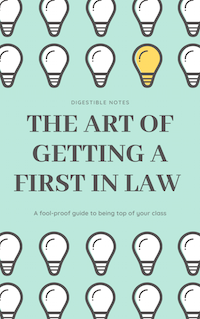Manslaughter: Constructive Manslaughter cases
Andrews v DPP [1937] AC 576
Facts: The appellant drove a van above the speed limit and overtook another car. As he did so he struck a pedestrian and killed him.
Held: His conviction for manslaughter was upheld. It is quite difficult to interpret the judgement, but seems to suggest strict liability offences and cases of negligence cannot exist in constructive manslaughter.
⇒ See the topic notes on constructive manslaughter here.
Attorney-General's Reference (No. 3 of 1994) [1997] 3 ALL ER 936
Facts: The defendant stabbed his pregnant girlfriend in the face, abdomen and back when she was 22-24 weeks pregnant. 17 days after the incident the woman went into premature labour and gave birth to a live baby. The baby died 121 days later due to the premature birth. The defendant was charged with wounding and GBH on the mother and convicted for which he received a sentence of 4 years. On the death of the baby he was also charged with murder and manslaughter.
Held: The House of Lords said he could not be charged with murder of the baby. However, his actions could amount to constructive manslaughter. There was no requirement that the foetus be classed as a human being provided causation was proved. The attack on the mother was an unlawful act which caused the death of the baby. There is no requirement under constructive manslaughter that the unlawful act is aimed at the actual victim or that the unlawful act was directed at a human being.
⇒ See the topic notes on constructive manslaughter here.
R v Carey [2006] EWCA Crim 17
Facts: Aimee Wellock, aged 15, and three friends went out for an early evening walk. They came across the three appellants who had been drinking. The appellants started making fun of Aimee and her friends and then became physically violent. Aimee had her head pulled back and was punched in the face. Two passing motorcyclists stopped and shouted at the appellants and they ran off. Aimee then ran off. She ran just over 100 metres but then unfortunately she collapsed and died. It transpired that she had a severely diseased heart and the run had induced a ventricular fibrillation which resulted in her death. The three appellants were convicted of affray and constructive manslaughter. They appealed against the manslaughter conviction.
Held: The manslaughter convictions were quashed. The physical assault on Aimee was not the cause of death. The cause of death was Aimee running away in fear.
⇒ See the topic notes on constructive manslaughter here.
R v Cato (1976) 62 Cr App R 415
Facts: The appellant purchased some heroin took it to his home which he shared with Anthony Farmer and two others. He invited them all to use the heroin. They each prepared their own solution and then paired off to inject each other. Farmer prepared his own solution and the appellant injected him. This was repeated during the night. The following day Farmer was found dead. The appellant was convicted of manslaughter and administering a noxious thing under s.23 OAPA 1861.
Held: Appeal was dismissed. The Conviction for manslaughter was upheld. The difficulty intros case was that it was said that the unlawful act (needed in constructive manslaughter cases) was possession, but this seems hard to support; it would have been better to have said the injecting of the drugs was the unlawful act as it poisoned the victim contrary to s.23 Offences Against the Persons Act 1861.
⇒ See the topic notes on constructive manslaughter here.
The Art of Getting a First in Law - ONLY £4.99
FOOL-PROOF methods of obtaining top grades
SECRETS your professors won't tell you and your peers don't know
INSIDER TIPS and tricks so you can spend less time studying and land the perfect job
We work really hard to provide you with incredible law notes for free...
The proceeds of this eBook helps us to run the site and keep the service FREE!

R v Dawson [1985] 81 Cr App R 150
Facts: The defendant and two other men carried out an attempted robbery at a petrol station. The cashier at the petrol station was a 60 year old man who, unknown to the defendants, suffered from a heart disease. Dawson had pointed a replica handgun at the victim and his partner had banged a pick-axe handle on the counter. Money was demanded, but the victim pressed the alarm button and the defendants fled empty handed. Shortly afterwards the victim collapsed and died from a heart attack.
Held: The defendants were not convicted of manslaughter. As the reasonable person in the defendants’ position during the attack would not have known of the man’s heart condition they cannot be guilty; in other words, the reasonable person would not see their actions as dangerous.
⇒ See the topic notes on constructive manslaughter here.
R v Dhaliwal [2006] EWCA Crim 113
Facts: The defendant had verbally abused his wife for many years. The wife committed suicide as a result of this abuse.
Held: The defendant was not guilty as he did not cause the death of his wife; whilst mental harm by way of a recognised mental condition can be classed as harm, mere emotions are not enough to qualify. The defendant’s wife did not commit suicide as an immediate and reasonable response to the verbal abuse, but acted voluntarily.
⇒ See the topic notes on constructive manslaughter here.
R v Goodfellow (1986) 83 Cr App R 237
Facts: The appellant had been harassed by two men and wished to move from his council accommodation. In order to get re-housed he set fire to his house making it look as if it had been petrol bombed. Unfortunately his wife, son and son's girlfriend all died in the fire.
Held: His conviction for manslaughter was upheld. There was no requirement that the unlawful act was directed at the victims nor that it was directed at a person.
⇒ See the topic notes on constructive manslaughter here.
R v Lamb [1967] 2 QB 981
Facts: Two boys were playing with a revolver. There were two bullets in the chamber but neither were opposite the barrel. The two boys believed that this meant it would not fire. One of the boys pointed the gun at the other and fired. As he pulled the trigger the chamber turned and the gun went off killing the boy. The other was charged with constructive (unlawful act) manslaughter.
Held: There was no unlawful act as no assault had been committed as the victim did not believe the gun would go off therefore he did not apprehend immediate unlawful personal violence.
⇒ See the topic notes on constructive manslaughter here.
R v Newbury [1977] AC 500
Facts: Two 15 year old boys threw a paving slab off a railway bridge as a train approached. The paving slab went through a glass window on the cab of the train and struck the guard killing him. The boys were convicted of manslaughter. The Court of Appeal dismissed the boys' appeals. The boys appealed to the Lords with the following certified question of law: “Can a defendant be properly convicted of manslaughter, when his mind is not affected by drink or drugs, if he did not foresee that his act might cause harm to another?"
Held: There is no requirement that the defendant foresees that some harm will result from his action.
⇒ See the topic notes on constructive manslaughter here.
R v Watson [1989] 2 ALL ER 865
Facts: The appellant smashed a window and broke into the house of an 87 year old man, Harold Moyler. Moyler went to investigate and the appellant shouted abuse at him and ran off. The police arrived and Moyler suffered a heart attack and died 90 minutes after the initial break in.
Held: His conviction was quashed as it could not be established that the break in was the cause of the heart attack. However, the Court of Appeal held that a sober and reasonable person would regard the act of the appellant as dangerous as they would have known of the age and frail condition of the victim.
⇒ See the topic notes on constructive manslaughter here.
Law Application Masterclass - ONLY £9.99
Learn how to effortlessly land vacation schemes, training contracts, and pupillages by making your law applications awesome. This eBook is constructed by lawyers and recruiters from the world's leading law firms and barristers' chambers.
✅ 60+ page eBook
✅ Research Methods, Success Secrets, Tips, Tricks, and more!
✅ Help keep Digestible Notes FREE

